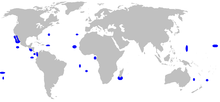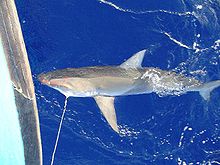Galapagos shark
| Galapagos shark | |
|---|---|

| |
| Scientific classification | |
| Domain: | Eukaryota |
| Kingdom: | Animalia |
| Phylum: | Chordata |
| Class: | Chondrichthyes |
| Subclass: | Elasmobranchii |
| Subdivision: | Selachimorpha |
| Order: | Carcharhiniformes |
| Family: | Carcharhinidae |
| Genus: | Carcharhinus |
| Species: | C. galapagensis
|
| Binomial name | |
| Carcharhinus galapagensis | |

| |
| Range of the Galapagos shark | |
| Synonyms | |
|
Carcharias galapagensis Snodgrass & Heller, 1905 | |
The Galapagos shark (Carcharhinus galapagensis) is a
The Galapagos shark is an active predator often encountered in large groups. It feeds mainly on bottom-dwelling
Taxonomy and phylogeny
The Galapagos shark was originally described as Carcharias galapagensis by
Garrick (1982) placed the Galapagos shark and the dusky shark at the center of the "obscurus group", one of two major groupings within Carcharhinus. The group consisted of the
Distribution and habitat

The Galapagos shark is found mainly off tropical oceanic islands. In the
The Galapagos shark is generally found over continental and insular shelves near the coast, preferring rugged
Description

One of the largest species in its genus, the Galapagos shark commonly reaches 3.0 m (9.8 ft) long. The maximum length has been variously recorded as 3.3 m (11 ft) to 3.7 m (12 ft).[8] The maximum recorded weight is 195 kg (430 lb) for a 3.0 m (9.8 ft) long female (longer specimens having apparently been unweighed).[9] This species has a slender, streamlined body typical of the requiem sharks. The snout is wide and rounded, with indistinct anterior nasal flaps. The eyes are round and of medium size. The mouth usually contains 14 tooth rows (range 13–15) on either side of both jaws, plus one tooth at the symphysis (where the jaw halves meet). The upper teeth are stout and triangular in shape, while the lower teeth are narrower; both upper and lower teeth have serrated edges.[7]
The first
Biology and ecology

The Galapagos shark is often the most abundant shark in shallow island waters.
During group interactions, Galapagos sharks are dominant to
Feeding

The primary food of Galapagos sharks are
Life history
Like other requiem sharks, the Galapagos shark exhibits a
Human interactions


Inquisitive and persistent, the Galapagos shark is regarded as potentially dangerous to humans. However, several live-aboard boats take divers to Wolf and Darwin, the northernmost Galapagos islands, every week specifically to dive in open water with these sharks where they and the scalloped hammerheads accumulate in numbers, and only a few incidents have been reported. They are known to approach close to swimmers, showing interest in
As of 2008, the Galapagos shark has been confirmed to have attacked three people: one fatal attack in the Virgin Islands;[16] a second fatal attack in the Virgin Islands, at Magens Bay on the north shore of St. Thomas;[17] and a third non-fatal, attack off Bermuda.[7][16] February 2018 saw a non-fatal shark attack in the Galapagos islands that shark photographer Jeremy Stafford-Deitsch suggested may have been carried out by a Galapagos shark, but the species remains unconfirmed.[18]
The
Conservation status
The New Zealand Department of Conservation has classified the Galapagos shark as "Not Threatened" under the New Zealand Threat Classification System with the qualifiers "Conservation Dependent" and "Secure Overseas".[19]
References
- ^ Bourdon, Jim. "The Life and Times of Long Dead Sharks". www.elasmo.com. Retrieved 2023-10-03.
- ^ . Retrieved 19 November 2021.
- ^ a b Snodgrass, R.E.; Heller, E. (January 31, 1905). "Papers from the Hopkins-Stanford Galapagos Expedition, 1898–1899. XVII. Shore fishes of the Revillagigedo, Clipperton, Cocos and Galapagos Islands". Proceedings of the Washington Academy is of Science. 6: 333–427.
- ^ a b c d e f g Bester, C. Biological Profiles: Galapagos Shark Archived 2010-04-30 at the Wayback Machine. Florida Museum of Natural History Ichthyology Department. Retrieved on April 26, 2009.
- ^ Garrick, J.A.F. (1982). "Sharks of the genus Carcharhinus". NOAA Technical Report, NMFS CIRC-445.
- S2CID 39697113.
- ^ ISBN 92-5-101384-5.
- ^ "Galapagos shark". FishBase.
- ISBN 9780195392944.
- ^ JSTOR 1444304.
- .
- JSTOR 3226388.
- S2CID 45413817.
- ^ S2CID 39220492.
- ^ ISBN 0-669-24646-8.
- ^ a b "ISAF Statistics on Attacking Species of Shark". International Shark Attack File. Florida Museum of Natural History, University of Florida. 24 January 2018.
- ^ Randall, J.E. (1963). "A fatal attack by the shark Carcharhinus galapagensis at St. Thomas, Virgin Islands". Caribbean Journal of Science. 3 (4).
- ^ Daniel O'Mahony (6 February 2018). "London businessman attacked by shark while snorkelling in the Galapagos Islands". Retrieved 11 February 2022.
- OCLC 1042901090.
External links
- "Galapagos Sharks ~ MarineBio Conservation Society". 2017-05-18. Retrieved 2022-02-13.
- "Terrifying account of a Navy SEAL killed by a shark". SOFREP. 2016-04-25. Retrieved 2022-02-13.
- Photos of Galapagos shark on Sealife Collection

